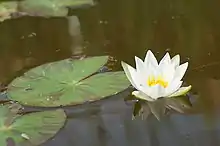Nymphaea tetragona
Nymphaea tetragona is a species of flowering plant commonly called pigmy waterlily[2] and small white water lily,[3] belonging to the family Nymphaeaceae.[4] In North America and Europe it native range is restricted to the boreal regions above 50° N latitude.[5]
| Nymphaea tetragona | |
|---|---|
 | |
| Scientific classification | |
| Kingdom: | Plantae |
| Clade: | Tracheophytes |
| Clade: | Angiosperms |
| Order: | Nymphaeales |
| Family: | Nymphaeaceae |
| Genus: | Nymphaea |
| Species: | N. tetragona |
| Binomial name | |
| Nymphaea tetragona Georgi | |
| Synonyms[1] | |
|
List
| |
Description
Nymphaea tetragona is an aquatic perennial with floating leaves and white flowers growing from unbranched rhizomes.[6] The leaves have entire margins and maybe tinted purple or sometimes mottled reddish brown or purple.[6] The receptacle is four-angled.[7] Plants produce a single floating flower that is 1.5 to 3 inches wide, with up to 15 petals; each flower has 30 to 45 yellow stamens.[3] The sepals and out petals are produced in whorls of four, the sepals are green in color.[3] The seeds are rounded in shape and 2-3 × 1.5-2 mm long, being 1.3-1.5 times as long as broad; the species has 112 pairs of chromosomes.[3] Flowering occurs in summer and the flowers close at night.
Distribution and habitat
Nymphaea tetragona inhabits ponds, lakes, and quiet streams;[3] and is native to: Alaska, Alberta, Altay, Amur, Assam, Bangladesh, Buryatiya, China North-Central, China South-Central, China Southeast, Chita, East European Russia, Finland, Hainan, Inner Mongolia, Irkutsk, Kamchatka, Kazakhstan, Khabarovsk, Korea, Krasnoyarsk, Kuril island., Magadan, Manchuria, Manitoba, Mongolia, Myanmar, North European Russian, Northwest European, Northwest Territories to British Columbia in Canada, Primorye, Sakhalin, Saskatchewan, Taiwan, Tibet, Tuva, Vietnam, Washington state in the USA, West Himalaya, West Siberia, Xinjiang, Yakutskiya, and the Yukon.[1] It is listed as a threatened species the US state of Minnesota, where it is found in slow moving streams often associated with beavers that provide suitable habitat by building dams.[7] In Minnesota the plants are typically found in water that is 1 to 2 meters deep growing in association with Zizania aquatica, Sagittaria sp, Scirpus sp, and Typha sp; Nymphaea odorata var. tuberosa and Nuphar variegata (Yellow Pond-lily) are also commonly found in the same locations.[7]
References
- "Nymphaea tetragona Georgi | Plants of the World Online | Kew Science". Plants of the World Online. Retrieved 2022-01-02.
- Google Books.
- "Nymphaea leibergii (Small White Water-lily): Minnesota Wildflowers". www.minnesotawildflowers.info. Retrieved 2022-01-01.
- "Nymphaea tetragona Georgi | Plants of the World Online | Kew Science". Plants of the World Online. Retrieved 14 February 2021.
- "Nymphaea tetragona in Flora of China @ efloras.org". www.efloras.org. Retrieved 2022-01-02.
- "Nymphaea tetragona in Flora of North America @ efloras.org". www.efloras.org. Retrieved 2022-01-01.
- Barbara Coffin; Lee Pfannmuller (1988). Minnesota's Endangered Flora and Fauna. U of Minnesota Press. p. 118. ISBN 978-0-8166-1689-3.